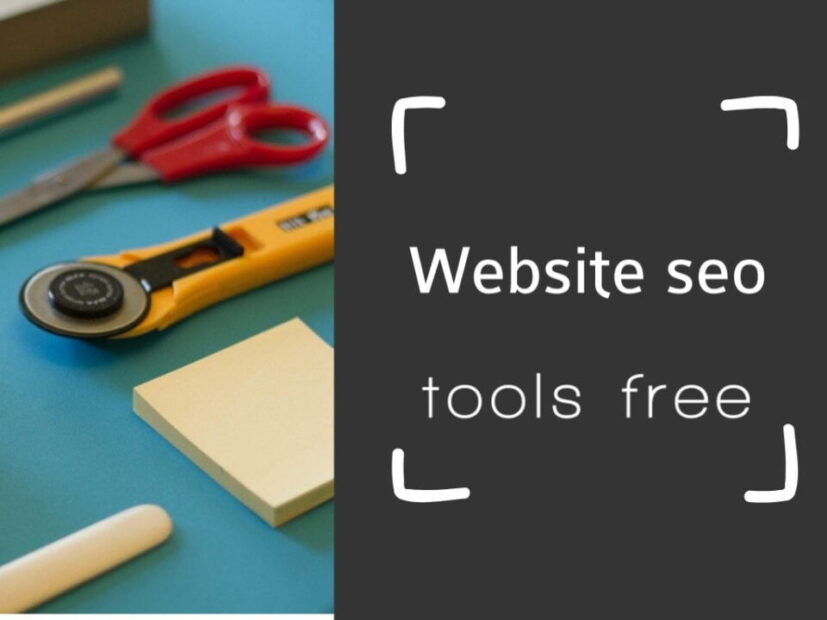Website SEO tools free: What if I told you that the key to elevating your website’s ranking on search engines could be achieved without spending a dime? Would you believe me if I said that there are powerful, free SEO tools available that can significantly enhance your website’s visibility and user experience?
The world of digital marketing is ever-evolving, and keeping up with SEO best practices is crucial for online success. But how do you navigate this landscape without breaking the bank? This is where free SEO tools come into play, offering a cost-effective solution to optimize your website effectively.
As we delve deeper into this guide, I will share with you the top free SEO tools and how to leverage them to unlock your website’s full potential. Let’s embark on this journey together and transform your website into an SEO powerhouse, using the best tools that the digital world has to offer, all without spending a penny.
Table of Contents
Elevate Your Website’s Visibility with Free SEO Tools
Did you know that over 90% of web pages receive no traffic from Google? This startling statistic highlights the importance of SEO in today’s digital landscape. Elevating your website’s visibility is crucial, and thankfully, it can be achieved with the strategic use of free SEO tools. These tools are not just cost-effective; they are pivotal in deciphering the complex algorithms of search engines and improving your site’s ranking.
Free SEO tools offer a gateway to understanding how search engines view your website. They provide insights into keyword performance, backlink quality, and website health, among other factors.
Most importantly, by identifying areas where your website may be lacking, you can make targeted improvements. This could involve enhancing your website’s content, structure, or technical SEO aspects. Leveraging these tools effectively can significantly increase your website’s visibility, drawing more traffic and, ultimately, conversions.
My suggestion for beginning this journey is straightforward: start with a comprehensive website audit using a free SEO tool. This audit will pinpoint exactly where to focus your optimization efforts. Following this, regularly monitor your site’s performance and adapt your strategy as needed.
Remember, SEO is not a one-time task but an ongoing process. From my perspective, the continuous use of these tools for monitoring and improvement is what will set your website apart from the competition.
Discover Hidden SEO Opportunities: Leverage Free Tools for Enhanced Performance
In the realm of SEO, uncovering hidden opportunities can be the difference between stagnation and growth. Free SEO tools are adept at revealing these opportunities, such as untapped keywords or underexplored content niches.
For instance, keyword research tools can uncover terms your target audience is searching for but that you may not have considered. Incorporating these into your content strategy can attract a wider audience and improve your site’s relevance.
Moreover, analyzing your competitors’ strategies is another way to discover opportunities. Free tools can provide insights into the keywords they rank for, the structure of their content, and their backlink profile.
By understanding what works for them, you can adapt and refine your own strategy to compete more effectively. In my opinion, this competitive analysis is invaluable for staying ahead in the SEO game.
Finally, enhancing your website’s performance goes beyond keywords and content. Technical SEO aspects, such as site speed, mobile-friendliness, and secure connections (HTTPS), play significant roles in search rankings. Free tools can help identify issues in these areas, allowing you to make the necessary adjustments.
My recommendation is to prioritize these technical improvements as part of your overall SEO strategy. Optimizing these elements can drastically improve user experience and, by extension, your site’s visibility.
Mastering SEO Optimization: A Guide to Utilizing Free Tools for Maximum Impact
SEO optimization is a broad term that encompasses a range of activities, all aimed at improving your website’s search engine rankings. Mastering this art begins with a deep dive into keyword optimization.
Selecting the right keywords is crucial, and free tools can help you identify those with high search volumes but low competition. Including these keywords naturally in your content can significantly boost your visibility.
Next, on-page SEO is an area where free tools can have a significant impact. These tools can analyze your content’s structure, meta descriptions, title tags, and more, offering recommendations for optimization.
My view is that on-page SEO is often underestimated, yet it is a critical component of a successful SEO strategy. By ensuring that each page on your site is fully optimized, you increase the likelihood of ranking higher in search results.
Lastly, content quality cannot be overlooked. Search engines favor content that is not only keyword-rich but also valuable and engaging to the reader. Free SEO tools that analyze content readability, structure, and engagement metrics can guide you in creating content that resonates with your audience and ranks well.
According to my experience, the combination of high-quality content and solid on-page SEO is a powerful one, capable of significantly elevating your site’s visibility. My intention is to remind you that, while the technical aspects of SEO are important, the core of your strategy should always focus on delivering value to your readers.
Boost Your Site’s Ranking with Effective Free SEO Strategies

It’s no secret that climbing the search engine rankings is a challenge, especially for newer or smaller websites competing against established giants. However, the landscape of SEO is such that, with the right strategies and tools—many of which are free—you can significantly improve your site’s visibility.
Effective SEO is not just about the tools you use, but how you use them to create a comprehensive strategy that covers all aspects of your online presence.
The first step in any SEO strategy should focus on understanding your audience and how they search for content related to your niche. This is where keyword research comes into play, serving as the foundation of SEO.
Free tools like Google Keyword Planner and Ubersuggest offer a wealth of data on keyword volume, competition, and trends. By targeting the right keywords, you position your website to attract more relevant traffic. It’s not just about getting any visitors to your site, but the right visitors.
Another crucial aspect is to regularly audit your website for SEO health. Free tools provide insights into how search engines view your site, identifying issues that might be hampering your ranking. These could range from broken links and slow loading speeds to poorly optimized content.
My recommendation is to conduct these audits periodically and act on the insights promptly. This proactive approach ensures that your website remains in tip-top shape, ready to climb the rankings.
Unleash the Potential of Keyword Research: Top Free Tools Revealed
While many recognize the importance of keyword research in SEO, not everyone knows how to do it effectively. The good news is, several free tools can simplify this process, offering insights into the keywords that can drive traffic to your site.
Google Keyword Planner is a great starting point, providing data directly from Google’s search engine. Similarly, tools like Answer The Public can help you understand the questions and phrases people are searching for, offering a unique angle to approach your content strategy.
Diving deeper into keyword research, it’s not just about finding high-volume keywords but understanding the intent behind searches. Tools like Ubersuggest and Keywords Everywhere help you analyze search intent, competition, and even suggest long-tail keywords that could be less competitive and more targeted.
From my point of view, focusing on these niche queries can often yield better results than aiming for broad, highly competitive terms.
Lastly, integrating your keywords naturally into your content is crucial. The aim is to create valuable content that answers your audience’s questions and solves their problems, with keywords woven seamlessly throughout.
This approach ensures that your content is not only SEO-friendly but also engaging and useful to your readers. I strongly believe that this balance is key to successful keyword strategy, leading to higher rankings and improved visibility.
On-Page SEO Mastery: Free Tools to Optimize Content and Meta Tags
On-page SEO is where you have the most control over your website’s SEO performance. It involves optimizing the content and the HTML source code of a page. Free tools like Yoast SEO for WordPress can guide you through optimizing your content and meta tags, ensuring that you’re following best practices for your targeted keywords.
These tools often provide real-time feedback on your content’s SEO performance, suggesting improvements and highlighting any issues.
Another critical aspect of on-page SEO is ensuring that your meta tags, including title tags and meta descriptions, are effectively optimized. These elements are what appear in the search results, and they play a significant role in whether a user decides to click through to your website.
Tools like MozBar can help you analyze and compare your meta tags against your competitors, providing insights into how you can improve your own tags to stand out in search results.
Incorporating multimedia elements like images and videos into your content is also a part of on-page SEO. It’s essential to ensure these elements are optimized—for instance, using appropriate alt tags for images, which improves accessibility and contributes to image search rankings.
I recommend using tools like TinyPNG for compressing images without losing quality, ensuring faster page load times and a better user experience.
Enhance Your Website’s User Experience with SEO Tools
“Speed does not only enhance the user experience; it also boosts your website’s visibility in search engine results.” This understanding is crucial in today’s fast-paced digital world, where the patience of visitors is ever-diminishing, and search engines like Google prioritize user experience as a key ranking factor.
Enhancing your website’s user experience is not just about aesthetics but also about its functional performance, which includes its speed and mobile responsiveness.
To begin with, website speed is a critical aspect of user experience. A fast-loading site not only keeps visitors engaged but also contributes positively to your SEO efforts. Free tools like Google’s PageSpeed Insights offer actionable advice on how to improve your website’s loading times.
Most importantly, this tool breaks down the performance on both mobile and desktop devices, offering specific recommendations for optimization. My suggestion is to prioritize the changes that have the biggest impact on speed, such as optimizing images and leveraging browser caching.
Another key aspect of enhancing user experience is ensuring that your website is mobile-friendly. With the majority of internet users accessing the web via mobile devices, your site must perform seamlessly across all screen sizes. Google’s Mobile-Friendly Test is a free tool that evaluates your website’s mobile design and usability.
According to my perspective, passing this test is not just about avoiding penalties from Google but about providing an optimal experience for the growing mobile audience. Implementing responsive design principles and optimizing for touch navigation can significantly improve your site’s mobile usability.
Speed Optimization Secrets: Free Tools to Accelerate Your Website
“Time is of the essence,” especially when it comes to website speed. Slow loading times can deter visitors and negatively impact your site’s search engine ranking. Thankfully, several free tools can help you identify and fix speed issues.
GTmetrix and Pingdom are excellent for gaining insights into your website’s performance, providing detailed reports on loading times and offering recommendations for improvement. My recommendation is to regularly monitor your website’s speed with these tools and implement their suggestions promptly.
Improving your website’s speed involves looking at various factors, from server response times to the size of images and scripts on your pages. Tools like WebPageTest allow you to test your site from different locations around the world, giving you a global perspective on its performance.
It’s important to optimize content delivery, perhaps through a Content Delivery Network (CDN), to ensure fast loading times worldwide. From my point of view, investing time in optimizing your website’s speed is a direct investment in improving user satisfaction and SEO.
Furthermore, optimizing your site’s code can play a significant role in improving speed. Minifying CSS, JavaScript, and HTML can reduce file sizes and make your website faster to load. Free tools like CSS Minifier and JavaScript Minifier can automate this process for you.
I believe that these technical optimizations, while they might seem small, add up to create a significantly faster website, enhancing the overall user experience and contributing to better SEO performance.
Mobile-Friendly Websites: Free Tools to Ensure Your Site is Mobile-Optimized
“In the palm of their hands, users hold the power to decide the fate of websites.” This statement underscores the importance of mobile optimization in today’s digital landscape. Ensuring that your website is optimized for mobile devices is no longer optional but a necessity.
Google’s Mobile-Friendly Test is an essential tool that analyzes your website to confirm its mobile-friendliness, offering specific recommendations for improvement if any issues are found.
Creating a mobile-optimized website involves more than just making sure your site fits on a smaller screen. It’s about ensuring that your content is easily readable, navigation is smooth, and interactive elements are easily clickable.
Free tools like BrowserStack allow you to test how your website looks and functions on a wide range of mobile devices. My advice is to use these insights to adjust your design and functionality, ensuring a seamless experience for all users.
Lastly, considering the mobile user’s journey on your website can lead to significant improvements in usability and satisfaction. Paying attention to the load times of your mobile site, the intuitiveness of your menu, and the ease of interaction with forms and calls to action is crucial.
Tools like Lighthouse, integrated into Google Chrome DevTools, provide audits of performance, accessibility, and more for the mobile web. In my view, focusing on these aspects will not only improve your site’s mobile-friendliness but also its overall performance across all platforms.
Building Quality Backlinks: Free Tools and Techniques

Just as a brick house is stronger with every well-placed brick, so too is a website with each quality backlink. Backlinks are a cornerstone of SEO strategy, much like bricks are to a house, providing support and strength to the site’s structure—in this case, its search engine ranking.
Yet, building a solid backlink profile is not about accumulating as many links as possible but focusing on the quality and relevance of those links. Here, free tools and techniques play a crucial role in identifying opportunities for building these valuable SEO assets.
The journey to building a robust backlink profile begins with understanding your current backlink situation. Tools like the Google Search Console offer a starting point, allowing site owners to see which websites link to their content.
This insight is invaluable, as it not only shows your site’s reach but also helps identify which types of content attract backlinks. My suggestion is to analyze these links for patterns that can inform your content strategy, focusing on creating more of what works.
Moreover, identifying potential new backlink sources is essential. Free tools such as Ubersuggest or Moz’s Link Explorer provide information on where competitors are getting their backlinks. This competitive analysis can uncover untapped opportunities in your niche.
From my point of view, learning from the success of others in your industry is a smart way to enhance your backlink strategy. Additionally, these tools can help you assess the quality of potential backlink sources, ensuring you pursue links that will positively impact your SEO.
Backlink Analysis Uncovered: Free Tools for Strategic Link Building
Strategic link building is akin to a chess game, where every move is calculated and intentional. It’s about placing your site’s links on relevant, authoritative pages that can drive both traffic and credibility to your site.
Free tools like Ahrefs’ Backlink Checker offer a glimpse into the power of backlink analysis, allowing you to see the top backlinks pointing to any website. This analysis can reveal not just where to build backlinks but also the quality of these potential links.
In the realm of backlink analysis, it’s important to consider the diversity of your link profile. A varied backlink profile, including links from different domains, industries, and types of websites, is seen as more natural and favorable by search engines.
Tools such as SEMrush offer features for analyzing this diversity, helping you to strategize where to focus your link-building efforts next. According to my experience, aiming for a broad range of high-quality backlinks can significantly enhance your SEO performance.
Furthermore, tracking the status of your backlinks over time is crucial. Links can be lost for various reasons, such as website closures or content changes, impacting your site’s SEO health.
Regular monitoring with tools like the Google Search Console ensures you’re always aware of your backlink profile’s current state. My recommendation is to conduct these checks regularly, allowing for timely responses to any lost links and maintaining your SEO strength.
Elevate Your Link Building Strategy: Free Tools for Finding Quality Backlinks
Elevating your link-building strategy involves not just finding any backlinks but securing high-quality ones that contribute to your site’s authority and search visibility. Tools like BuzzSumo can be instrumental in this process, enabling you to discover popular content within your niche and identify where these pieces are getting their backlinks. By understanding what content within your industry attracts links, you can tailor your content to be more link-worthy.
Additionally, engaging in smart outreach is a key technique for acquiring new backlinks. This involves reaching out to websites and influencers within your niche to share your content, hoping they find it valuable enough to link back to.
Tools like Hunter.io can help you find contact information for these potential link partners, making outreach efforts more targeted and effective. From my perspective, personalized and well-researched outreach emails are far more likely to yield positive results.
Lastly, creating linkable assets such as original research, infographics, or comprehensive guides is a proven method to attract quality backlinks. These types of content offer significant value to readers and are therefore more likely to be shared and linked to.
While creating such content requires investment in time and resources, the potential SEO benefits are substantial.
My intention is to highlight that by focusing on creating high-value content, you naturally encourage others to link to your site, thereby strengthening your SEO foundation with high-quality backlinks.
Stay Ahead of the Competition with Comprehensive SEO Analysis
A staggering 70-80% of users ignore paid ads, focusing instead on organic search results. This fact underscores the critical importance of SEO in capturing the attention of potential customers.
In a digital landscape crowded with competitors vying for the top spot on search engine results pages (SERPs), conducting a comprehensive SEO analysis becomes not just beneficial but essential for staying ahead.
Such an analysis encompasses understanding your own SEO performance, scrutinizing your competitors’ strategies, and keeping abreast of the latest trends and algorithm updates.
Embarking on this journey of SEO analysis, the first step involves a deep dive into your website’s current SEO health. Tools like Google Analytics and Google Search Console provide a wealth of data on your site’s traffic, keyword rankings, and user behavior. These insights are invaluable for identifying both strengths and areas for improvement.
Most importantly, they lay the groundwork for a strategic plan aimed at enhancing your website’s visibility and engagement. My suggestion is to regularly review this data, allowing for agile adjustments to your SEO strategy in response to your findings.
Next, understanding the competitive landscape is crucial. Free tools like Ubersuggest and Moz’s Link Explorer offer the capability to peek into your competitors’ SEO tactics, from the keywords they rank for to their backlink profiles. This competitive analysis not only reveals gaps in your own strategy but also uncovers opportunities for growth.
In my view, leveraging this information can propel your SEO efforts, positioning your website to capture traffic that might otherwise go to your competitors. It’s about finding the sweet spot where you can differentiate your content and offerings to fill unmet needs within your target market.
Competitive SEO Analysis: Free Tools to Spy on Your Competitors
“Keep your friends close and your enemies closer,” holds true in the realm of SEO, where knowing your competitors’ strategies can provide a significant advantage. A comprehensive competitive SEO analysis involves more than just a cursory glance at their websites.
It requires an in-depth look at their SEO efforts, understanding which keywords they are targeting, the quality of content they are producing, and how they are acquiring backlinks. Free tools like SEMrush’s free version offer a peek into your competitors’ traffic sources, keywords, and rankings, giving you a clearer picture of what you’re up against.
Armed with this knowledge, the aim is to identify areas where your competitors may be outperforming you and to strategize on how to close that gap. It could mean revamping your content strategy, enhancing your website’s user experience, or adopting new SEO techniques that you hadn’t considered before.
My recommendation is to not just emulate your competitors but to find innovative ways to outdo them. This could involve targeting overlooked keywords, improving the quality and depth of your content, or strengthening your site’s technical SEO.
Furthermore, monitoring your competitors’ backlink strategies can uncover new opportunities for your own link-building efforts. Tools like Ahrefs’ Backlink Checker (in its free mode) allow you to see where your competitors’ backlinks are coming from.
This insight can guide you towards potential partnerships or guest posting opportunities. In my estimation, a well-rounded understanding of your competitors’ backlink profiles can inform a more effective link acquisition strategy, helping boost your own site’s authority and rankings.
SEO Trends and Insights: Free Tools for Market Analysis and Adaptation
In the fast-evolving world of SEO, staying informed about the latest trends and algorithm updates is crucial for maintaining and improving your site’s ranking. Tools like Google Trends and BuzzSumo offer valuable insights into what topics are currently popular and how user search behavior is changing over time.
By aligning your content strategy with these trends, you can ensure that your website remains relevant and continues to attract organic traffic.
Moreover, adapting to new SEO technologies and methodologies is essential for staying ahead. For example, the rise of voice search and mobile-first indexing by search engines has shifted the focus towards optimizing for voice queries and ensuring websites are mobile-friendly.
Utilizing Google’s Mobile-Friendly Test and incorporating long-tail keywords that mimic natural speech patterns can position your website favorably for these emerging trends.
Lastly, keeping an eye on the future direction of SEO and preparing for it is something I strongly believe in. Whether it’s the potential impact of AI and machine learning on search algorithms or the increasing importance of E-A-T (Expertise, Authoritativeness, and Trustworthiness) in content evaluation, being proactive rather than reactive can set your website apart.
My intention is to encourage you to regularly educate yourself on these developments and consider how they could affect your SEO strategy. Engaging with a community of SEO professionals and staying updated with reputable SEO news sources can provide you with the knowledge and tools necessary for adapting to the ever-changing SEO landscape.
Frequently Asked Questions (FAQ)
What are free SEO tools, and why are they important?
Free SEO tools are software applications that help you optimize your website for search engines without any cost. They are important because they enable website owners and digital marketers to improve their website’s visibility on search engine result pages (SERPs), enhance user experience, and ultimately drive more organic traffic to their site. These tools offer functionalities like keyword research, backlink analysis, site audits, and performance tracking.
Can free SEO tools be as effective as paid ones?
Yes, free SEO tools can be highly effective, especially for small businesses, startups, and individual bloggers. While paid tools often offer more advanced features and comprehensive data, free tools can still provide valuable insights and help you achieve significant SEO improvements.
What are some of the best free SEO tools available?
Some of the best free SEO tools include:
Google Analytics: Tracks website traffic and user behavior.
Google Search Console: Monitors website performance and indexing status.
Ubersuggest: Provides keyword suggestions and domain overview.
Moz Link Explorer: Analyzes backlinks and domain authority.
Yoast SEO: Optimizes on-page SEO for WordPress sites.
SEMrush Free Version: Offers keyword research and competitive analysis.
AnswerThePublic: Generates content ideas based on popular search queries.Are there any limitations to using free SEO tools?
While free SEO tools are beneficial, they do come with limitations such as:
Data Restrictions: Limited access to data and fewer features compared to paid versions.
Usage Limits: Daily or monthly usage limits on certain functionalities.
Support: Less customer support or community assistance.
Advanced Features: Lack of advanced features such as in-depth competitor analysis and historical data.Can I rely solely on free SEO tools for my website’s SEO strategy?
While you can achieve significant improvements using free SEO tools, relying solely on them may not be sufficient for highly competitive industries or large websites. As your website grows, investing in paid SEO tools can provide more comprehensive data, advanced features, and better support to refine and enhance your SEO strategy. However, for many small to medium-sized websites, free tools are often adequate to achieve good results.






